How can room acoustics in the office be improved?
Sound insulation and acoustic elements for a pleasant working environment - We show you how.
The complex issue of acoustics is extremely important, especially in the workplace, and is still far too often neglected - despite the fact that around 70 percent of all employees work in offices today. The numerous sources of noise in the office, such as telephone calls, printers, conversations between colleagues, telephone ringing and ventilation systems quickly cause the noise level to rise unpleasantly and can quickly become a burden without sound insulation. Structural conditions, such as hard and sound-reflecting materials, concrete walls and glass fronts, also contribute to poor room acoustics, which can lead to poor concentration, reduced performance and high stress levels. Optimized room acoustics, on the other hand, create a pleasant working atmosphere and reduce noise as well as poor speech intelligibility. Every investment in good room acoustics is therefore an investment in satisfaction, health and the ability to concentrate, and thus in the efficiency of employees. A number of measures can be used to make an office acoustically more pleasant. For example, noise can be reduced by installing acoustic absorbers in the form of ceiling and wall panels, room-in-room systems or simple movable walls or desk absorbers. Most sound-absorbing solutions are designed to be functional and understated. However, there are also designs that combine the practical with the decorative. We will be happy to create a concept of measures for you and advise you holistically on which measures can be implemented immediately and which should be adapted in the long term.
Smart solution - acoustic boxes from coneon
Our tip: The optimal solution for undisturbed work
Looking for a quick acoustic solution for meetings and concentrated work?
Acoustic boxes are a must-have for any office! Their versatility allows them to be used in any office. Experience impressive soundproofing and isolation with acoustic boxes from coneon. They provide the desired retreat in offices and allow for privacy. Acoustic boxes are optimal for phone calls, small meetings and discussions, or productive one-on-one work.


What is the cause of poor acoustics in the office?
The main cause of poor room acoustics, is the use of too many sound-reflecting surfaces in the room, without the use of acoustic elements or an unfavorable room layout. Sound-reflecting surfaces include, for example, floor-to-ceiling glass walls, concrete, smooth walls and ceilings in general, metal or hard floor coverings. These materials are particularly prevalent in modern office buildings, which are often built in loft and industrial designs. Modern architecture often does not sufficiently consider the acoustic aspect, which can lead to poor room acoustics. In such rooms, it can become very noisy due to the many sound-reflecting surfaces and the lack of absorbent materials. Textile shades on windows or even carpets increasingly disappear from the rooms, allowing sound to reflect unhindered in the room. When several people are talking or on the phone at the same time, an unpleasant noise level can quickly arise, especially in open-plan offices.
Due to minimalist furnishings and the large, bare surfaces, sound spreads through reflections in all areas of the room. However, not only in open-plan offices, but also in all other office spaces or in the home office, too high a noise level can quickly be reached if the room is not treated acoustically. To achieve excellent speech intelligibility, the reverberation time should be reduced using absorbent material. Sound waves must be prevented from sloshing back and forth in the room. This may require different measures depending on the room and depends on the size of the room and the absorbent items already present - such as certain materials, objects and people.
To achieve optimal acoustics in a room, several factors related to sound waves must be considered. The acoustics of a room are determined by the absorption, attenuation and diffusion of sound waves. To achieve a concentrated working atmosphere, even in large offices, sounds in the room must be either absorbed, attenuated or diffused. Acoustic calculations and precise measurements can be used to determine the optimal location for sound absorption devices. This makes it possible to find an individual, customized acoustic solution for each room.
Fact: Noise in office spaces increases mental strain, causes stress and impairs concentration. Especially in open-plan offices, the use of acoustic elements is a necessary means of maintaining the health and efficiency of employees.
Why is soundproofing in the office so important?
Protection against noise in the office not only has legal reasons, but there are also numerous other arguments in favor of using acoustic elements. The workplace guidelines and other legal regulations regarding noise and loudness can serve as orientation here. You can find out more about this on our article on the subject of workplace guidelines relating to noise and loudness. However, it is advisable to implement sound insulation in the office, especially for health reasons. Too high a noise level can impair employees' concentration and thus reduce their performance. But not only that - permanent noise pollution can cause serious health problems, such as stress, tension, nervousness, sleep disorders and cardiovascular problems. As a result, sick leave can be the consequence. The use of acoustic elements is therefore a necessary means of maintaining the health and efficiency of employees.
Increased concentration
Concentrated work
due to early absorption of sound.
Improved well-being
Less noise pollution and more privacy thanks to acoustic elements.
Undisturbed communication
Improve communication through specially arranged zones.
Efficient use of space
Flexible room layout due to free-standing acoustic elements.

Different acoustic elements and their advantages.
How can I improve the room acoustics in my office?
Noise in the office can be reduced and acoustics improved with simple measures and the right acoustic elements. One option is absorbers, which absorb sound waves and thus reduce reverberation. They can be used in the form of wall panels, ceiling sails or free-standing elements. Another option is sound and privacy screens, which not only improve acoustics but can also provide more privacy. Carpets, curtains and other textiles can also help absorb sound. Finally, there are also acoustic pictures or plants that not only have a decorative function, but also help to improve the acoustics of the room. It is important to examine the various options and select the appropriate acoustic elements to create an optimal working environment that promotes the health and well-being of employees. coneon will be happy to create a concept of measures for you and advise you in detail.
Acoustic elements for wall and ceiling
To dampen reverberation and sound in office spaces, system solutions such as the installation of an acoustic ceiling or suspended ceiling can be useful. These can absorb the sound in the room and thus reduce reverberation. Another alternative is acoustic sails or sound absorbers in suspended cassettes on the walls or ceiling.
These solutions are not only functional, but can also be designed to be visually appealing, for example, by matching the existing room design with a noble felt cover.




It is also possible to place acoustic solutions above workstations or high-traffic areas to reduce noise directly at the source. Suspended acoustic elements also offer another advantage: they save space in the office. Unlike standing acoustic elements, they don't take up valuable floor space, leaving more room for furniture and work surfaces. In addition, hanging acoustic elements can be placed specifically where they are needed most, without interfering with the flow of work or freedom of movement in the office.






Sound absorber at the workplace
To reduce background noise in the workplace, table stands or table dividers can be a good solution. These acoustic elements are often used as an effective method of sound absorption to improve employee privacy and concentration. However, it is important to consider the height of the elements when choosing the right table dividers. If they are too low, sound waves can easily be transmitted across the desk separator, reducing the effectiveness of the acoustic elements. To avoid this, a simple test should be performed: If employees can see over the table divider, it is usually too low.



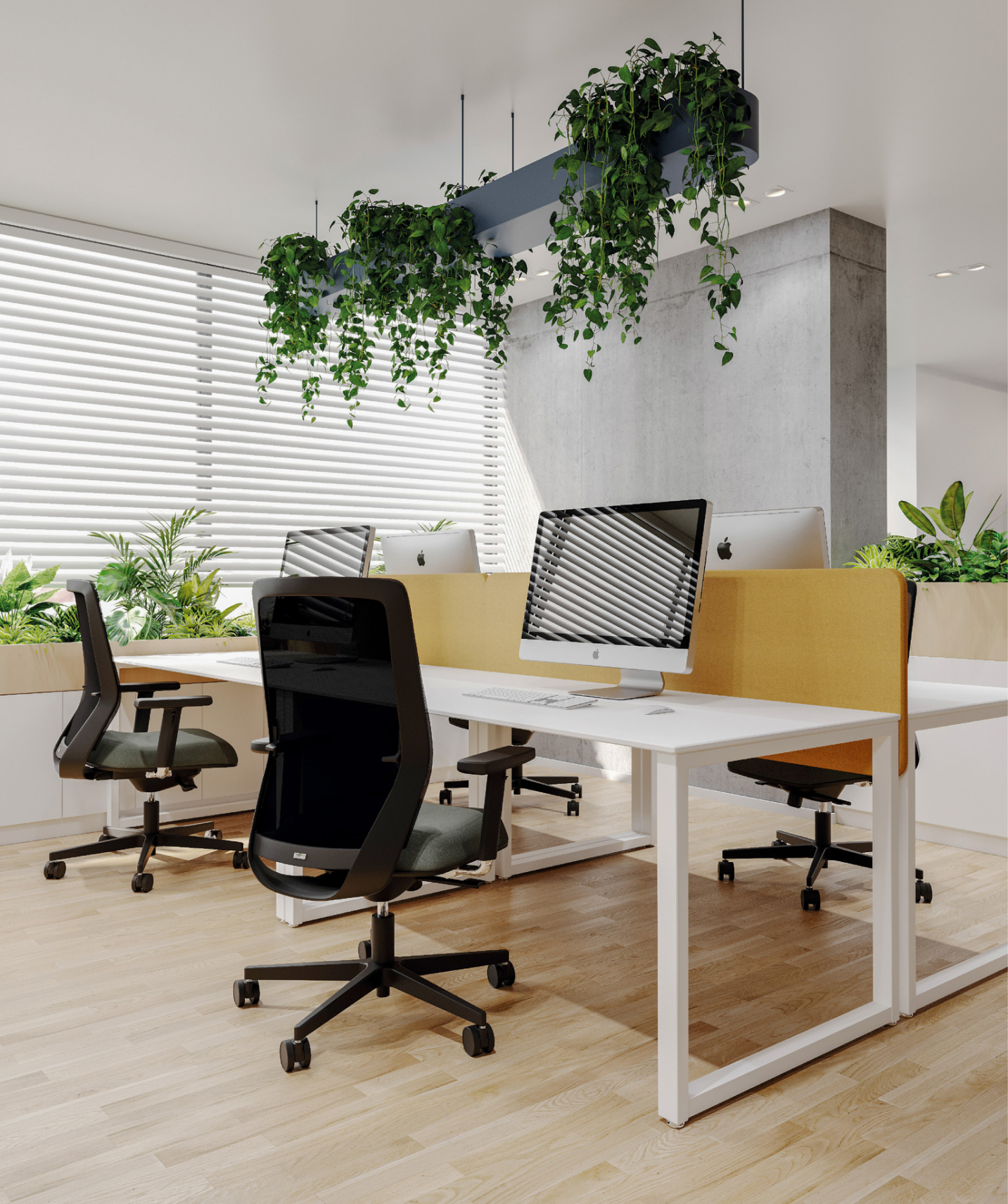
Alternatively, there are also table dividers that you can slide on a rail. If you then want to talk to the person sitting next to you, you can simply slide the partition away. There are also clear acoustic dividers if you want to make the concept more open. Another way to use desk stand-ups is to equip existing desk dividers with soundproofing mats to reduce the spread of noise. The advantage of desk stand-ups is their space-saving installation compared to standing acoustic elements, which require a lot of floor space in the office.



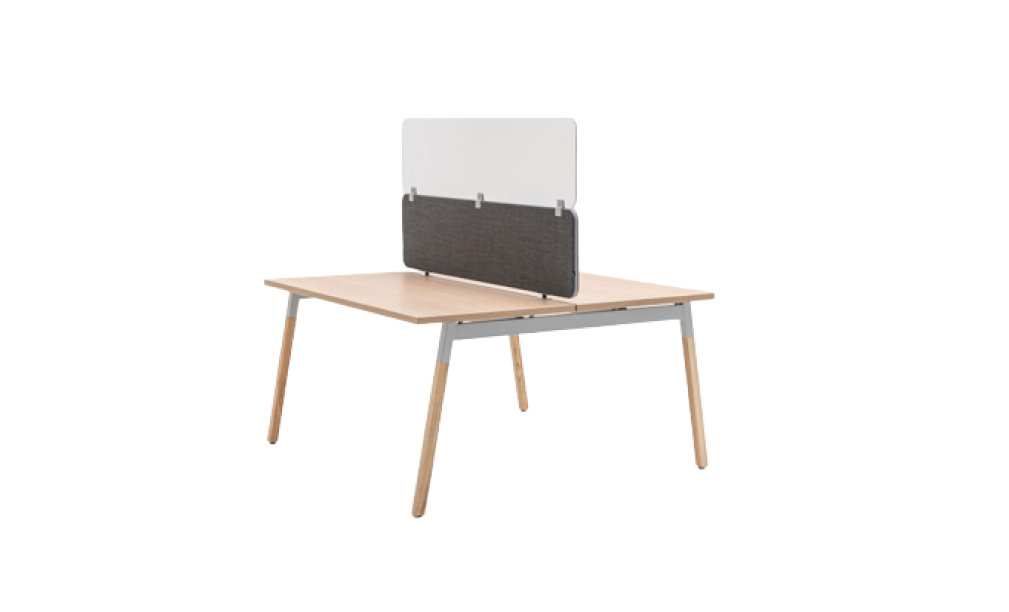
Freestanding acoustic elements - room dividers
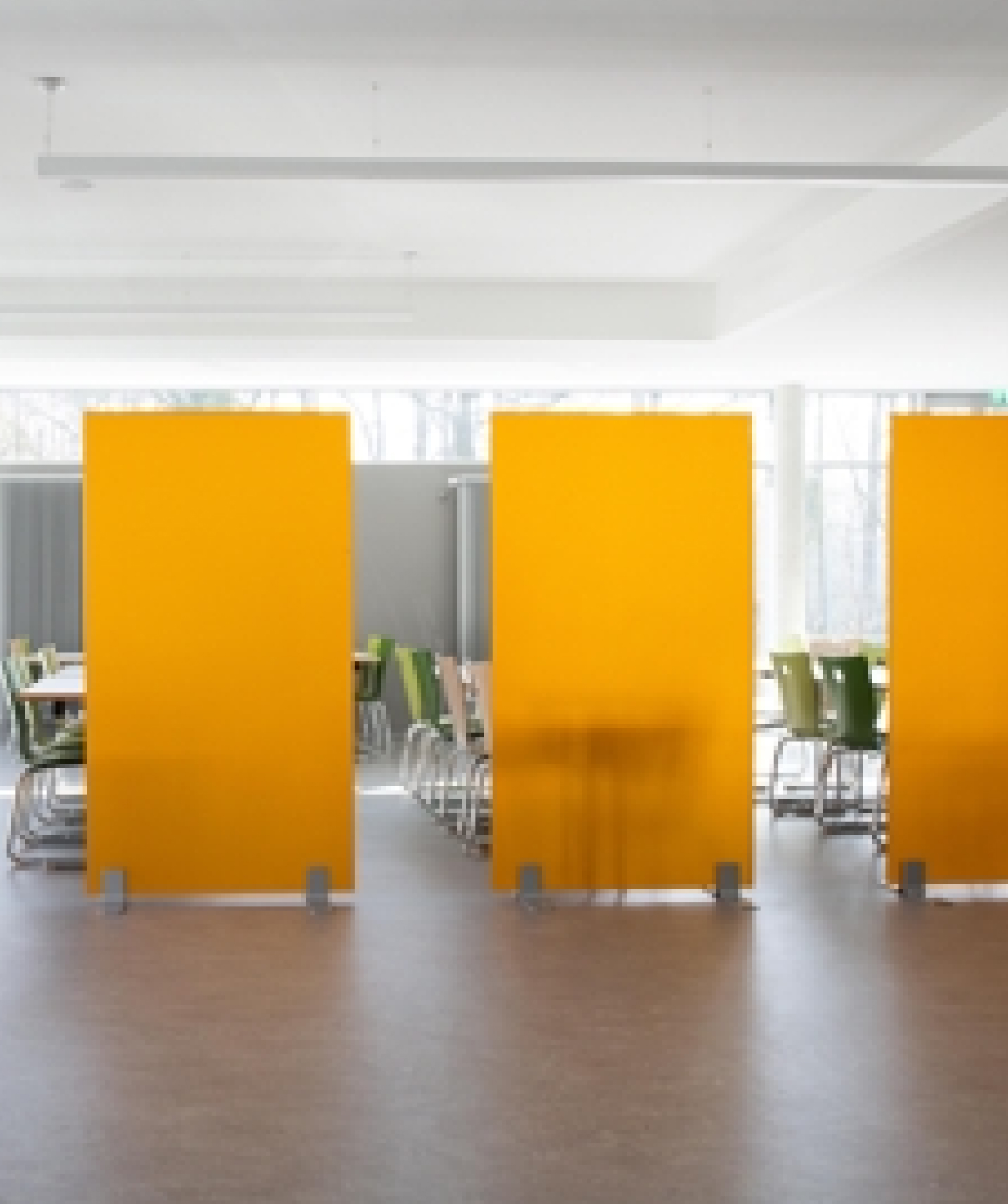

Free-standing acoustic elements offer many advantages in the office. One of the biggest advantages is their mobility, as they can be moved easily and quickly. This allows them to be used flexibly to separate different work areas in the office or to change them as needed. Another advantage is their multifunctional use, as they can be used not only as a sound barrier, but also as a bulletin board or for attaching notes and plans. In addition, they provide more privacy and thus increase concentration and productivity at the workplace. Free-standing acoustic elements also visually enhance the room and contribute to an individual design.






Acoustic boxes
When 10 people in an office are on the phone at the same time, even the best acoustic elements are of no use. Therefore, it makes sense to create small retreat areas in the company, where employees can work or talk on the phone undisturbed for a few hours. These rooms can look very different and can even be located within the group office. Acoustic boxes offer a place of retreat in the middle of office life. A refuge for highly concentrated work and new ideas, acoustically shielded and equipped with all technical interfaces. Another advantage of acoustic boxes is their ability to increase privacy. In work environments where confidential information is discussed, acoustic boxes can serve as a safe place to maintain confidentiality.








Acoustic furniture
Acoustic upholstered furniture is a great way to improve the acoustics in an office. They absorb sound waves and thus reduce reverberation in the room. By using acoustic upholstered furniture, employees can talk on the phone or work without being distracted by the background noise in the room. This can lead to higher productivity and a better working environment.
In addition to the functional benefits, acoustic upholstered furniture also offers a stylish aspect that can improve the aesthetics and design of the office. There are a variety of acoustic upholstered furniture available in different styles, colors and shapes. So, not only can they improve acoustics, but they can also help create a modern and appealing atmosphere in the office, as they do not stand out as an acoustic element per se, but rather blend unobtrusively into the office concept.







Phone Points – Telephone workstations
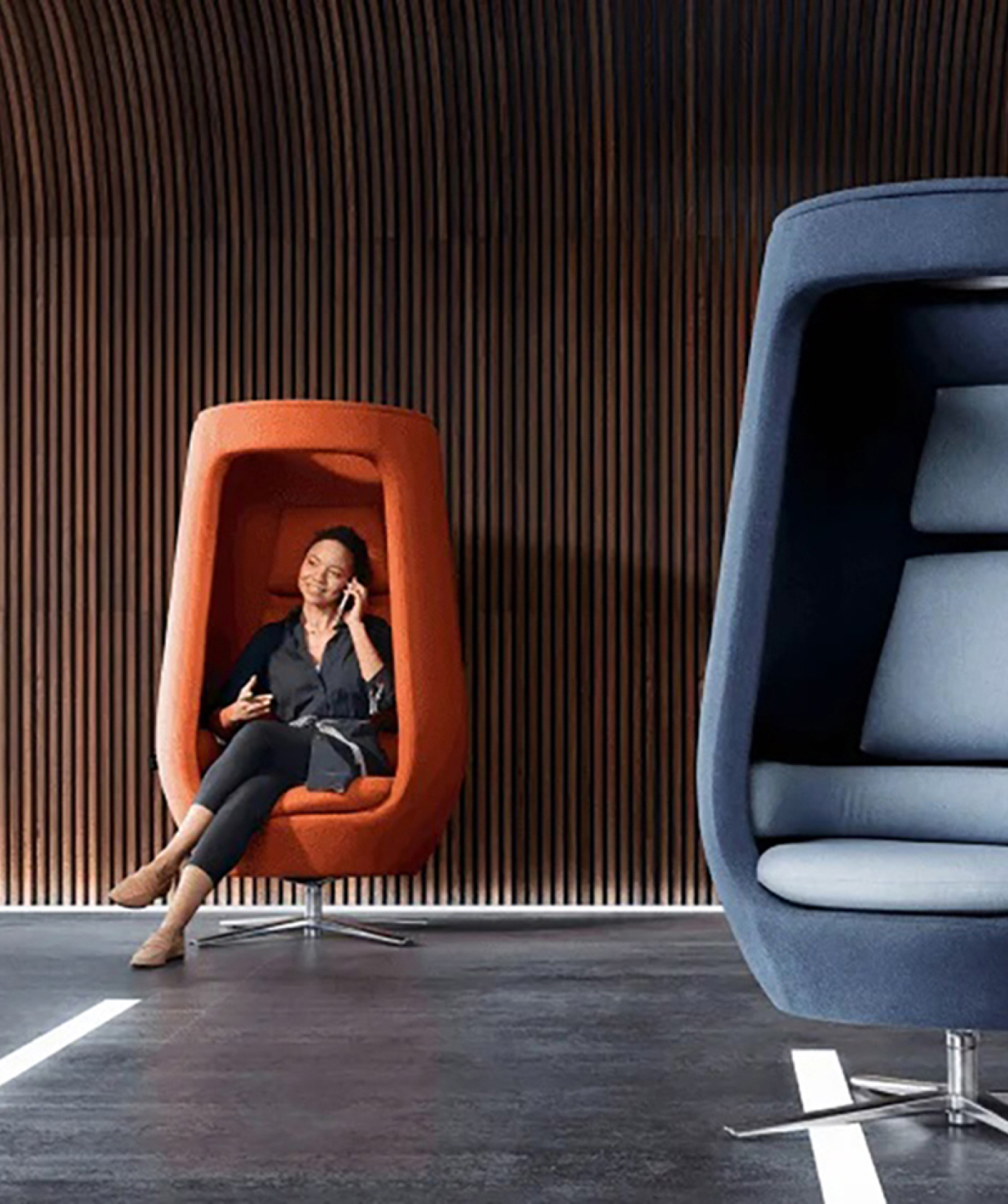

Phone Points provide an opportunity in an open office space to make phone calls in privacy in a more protected location. Even though the rounded phone points are open, they offer a bit of privacy.
Phone Points absorb sound due to the material and shape, making them a good solution for quick phone calls in a noisy open area.




Acoustic pictures & acoustic elements in corporate design
Acoustic pictures are invisible acoustic elements, as the viewer does not recognize them as an acoustic measure. They are an innovative solution for improving room acoustics in living and working areas. The special images consist of a sound-absorbing core and a high-quality textile cover that can be printed with individual designs.
Another advantage of acoustic pictures is their flexibility in terms of design and size. They can be customized and are available in different sizes and shapes, so they can be adapted to any wall and corporate design. In some cases, these pictures are also available with an integrated sound system or heating.


Other acoustic solutions


A meeting swing creates an informal, creativity-stimulating meeting space while bringing pleasant, demised acoustics to the office. In this protected atmosphere of free discussion, highly inspiring, surprising ideas can emerge. Acoustic curtains are sound-absorbing and sound-insulating, and can also act as privacy or sun shades. They are available in numerous designs.




Example concept - acoustic planning office
What can an office space with good acoustic design look like?

1. acoustical analysis
At the beginning of the design process, a thorough acoustic analysis of the office is performed. Measurements of reverberation, sound transmission and background noise are taken to evaluate the current state of the acoustics in the room. These data serve as a starting point for the implementation of the following measures.
2. room design
Interior design plays an important role in creating good acoustics. Materials and surfaces should be selected that have a sound-absorbing effect, as described in advance. For example, acoustic partitions between desks, curtains, wall panels and sound-absorbing furniture can be used to reduce reverberation in the room. The office layout should also be designed to minimize sound reflections, for example by using free-standing acoustic elements or acoustic murals.
3. room acoustics management
Effective room acoustics management is crucial to adjust the acoustics in the office and meet the needs of employees. Various technologies can be used for this purpose, such as sound-absorbing ceiling canopies with integrated sound control. These allow individual adjustment of the acoustics in specific areas of the office, depending on requirements and the type of activity.
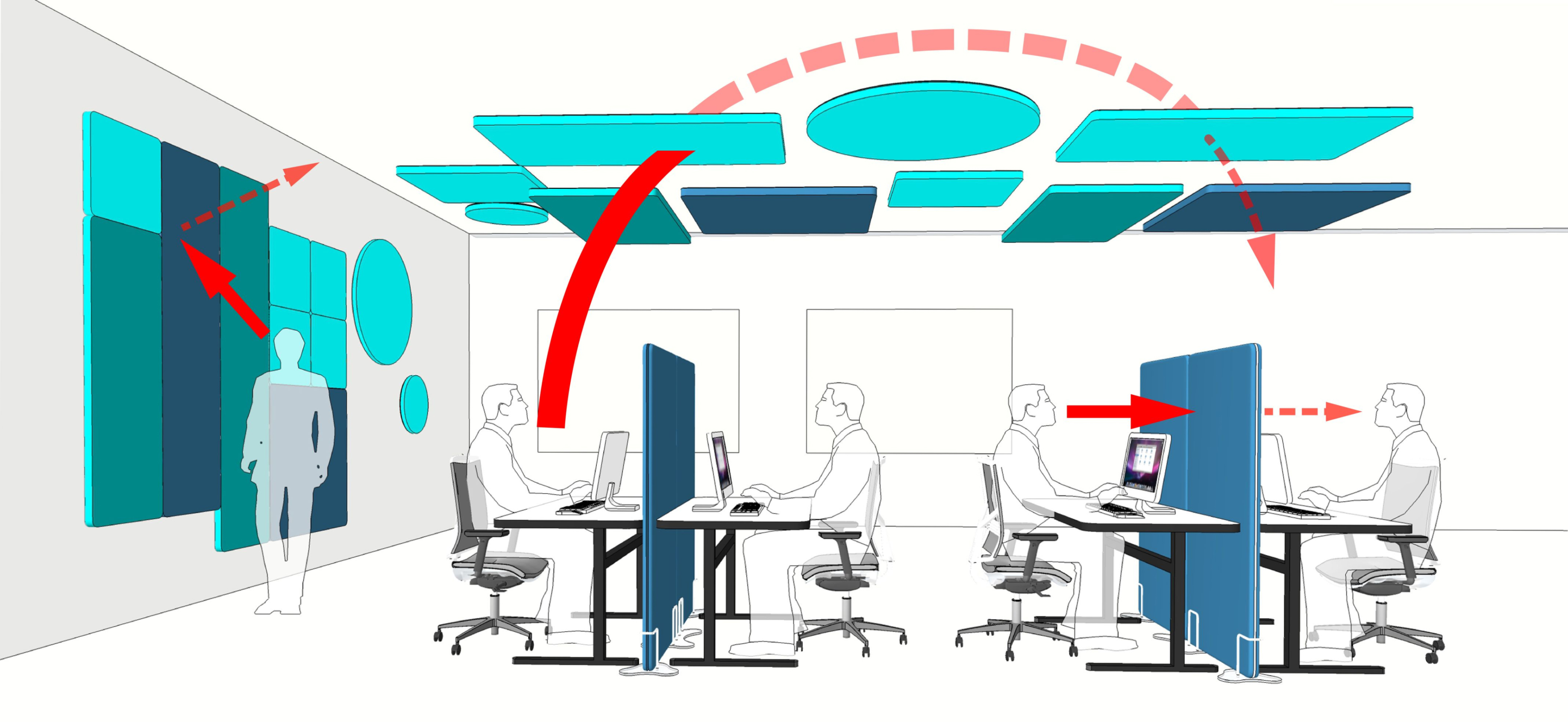
4. sound source control
Sound sources such as electronic equipment should be as quiet as possible and placed as far away as possible from work areas, or shielded by acoustic room dividers. When selecting office furniture, sound-absorbing materials should be preferred. In addition, sound barriers such as plants or acoustic columns can be used to absorb and reduce sound.
5. acoustic sensitization
To raise awareness of the importance of good acoustics and encourage employee behavior, a training or awareness campaign should be conducted. By becoming aware of how their own actions affect the acoustics in the office, they can take more targeted action to create a comfortable and productive work environment for everyone. For example, using acoustic boxes for meetings, using headsets to make phone calls, or typing more quietly on the keyboard.
Before a new room concept is created, we at coneon take a close look at your situation and analyze which are the main reasons for poor room acoustics and advise you which measures can be implemented immediately and which should be adapted in the long term.
You want to improve the acoustics in your office, need acoustic planning or are interested in acoustic elements?
We will be happy to draw up a concept of measures for you and advise you holistically on which measures can be implemented immediately and which should be adapted in the long term.

